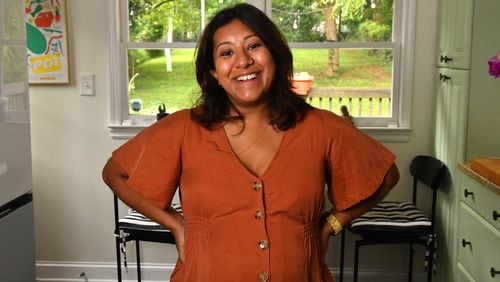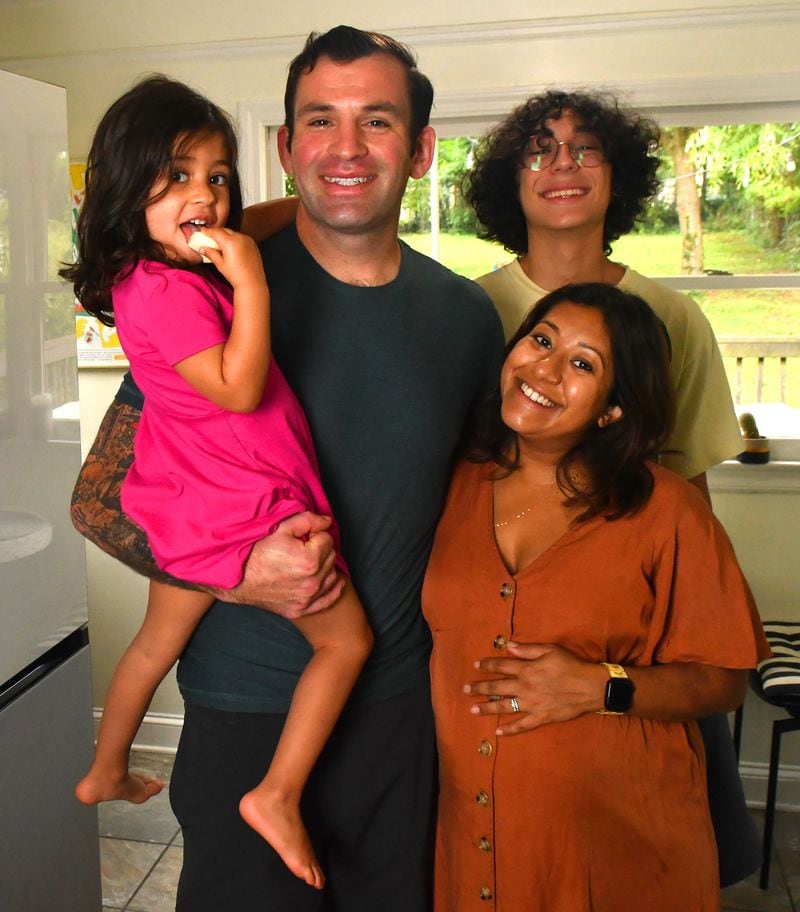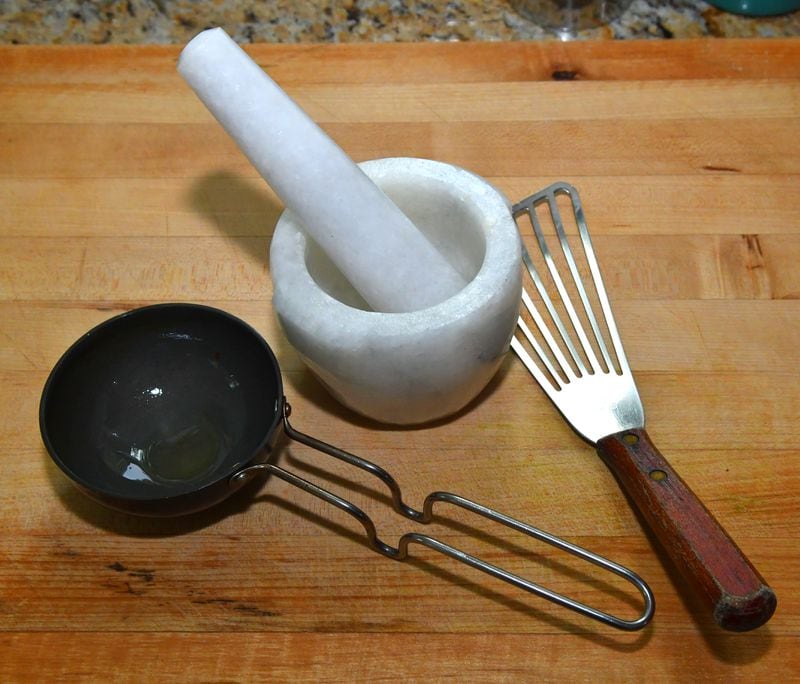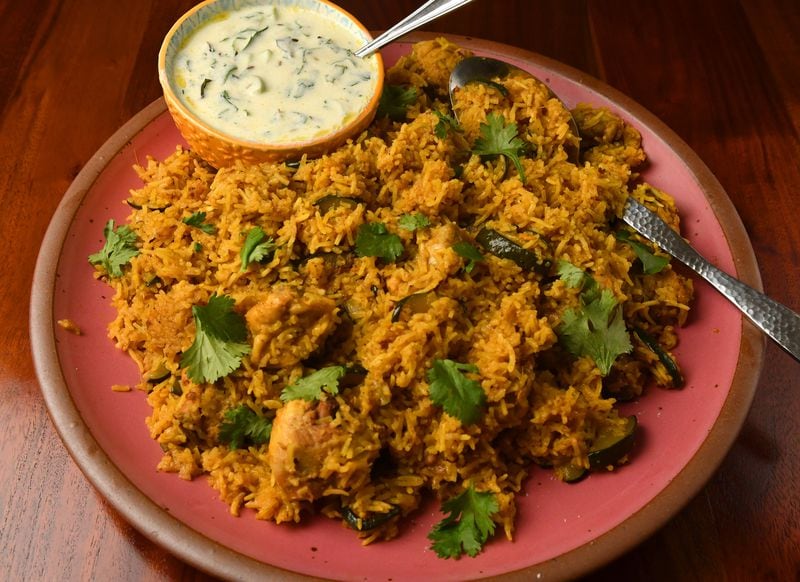Food has long played an important part in Sahar Siddiqi’s life. During her childhood in New York, the first-generation Pakistani American was impressed by her mom’s grand dinner parties. As a college student in Manhattan, she spent all her money on eating experiences. While studying at the Culinary Institute of America in Hyde Park and working an externship at Saveur magazine, she found her place in the publication’s test kitchen.
It was during her journey through the ranks at State Bird Provisions in San Francisco that she realized she wanted to cook in restaurants for the rest of her life. She fell in love with seasonal, local produce. She and chef husband Gabriel Johnson immersed themselves in the food of southeast Asia during their honeymoon and six-month leave of absence. Straight from the culinary trip, they moved to Atlanta for Johnson’s job. After Siddiqi’s stint at Staplehouse, chef Christopher Grossman (who worked at The French Laundry and knew the State Bird Provisions team) offered her a job at Atlas. A year and a half later, chef-owner Meherwan Irani of Chai Pani in Decatur enticed her to join his team. Now the 2023 James Beard semifinalist for Best Chef: Southeast is Chai Pani’s chef de cuisine and the restaurant’s menu includes one of her mom’s famed recipes.
“I feel like I’ve spent my entire career cooking other people’s food and I’m finally cooking food that I only dreamed of cooking,” said the 34-year-old Siddiqi. “It’s pretty special to be recognized for cooking food so close to my heart.”
Credit: CHRIS HUNT
Credit: CHRIS HUNT
Q: What is your favorite cuisine to cook at home?
A: I love cooking Pakistani cuisine at home. That’s how I grew up. (It’s) the food I feel most connected to. It’s very reminiscent of my childhood and I want to give that to my daughter.
Q: What are your favorite ingredients to cook with at home?
A: I’m really into cooking seasonal, local produce and local foods. We always have Four Bellies chicken in our freezer. We cook it once a week in a hundred different ways — grilling, stewing, curry. And we are a vegetable family. We grow eggplant, tomatoes, cucumbers, okra.
Q: What is your go-to dish for a quick dinner?
A: A one-pot chicken situation, like a variety of pulau (a rice dish) where you make a flavorful broth and cook the rice in that, then throw in some vegetables. So it hits all the notes. It’s very comforting and comes together in 30 minutes.
Q: When time is not a factor, what dish do you like to prepare at home?
A: I go for mutton from the halal butcher and make some deep, rich curry that takes hours to cook and there’s a million different ingredients in it. Also, I like smoking a whole leg of lamb and doing fresh pita and the accoutrements.
Q: What do you cook for yourself at the end of a long workday?
A: Soft scrambled eggs on toast and I’m happy. It’s so satisfying.
Q: What are some of your favorite cookbooks in your collection?
A: I have a lot of (Yotam) Ottolenghi cookbooks. I Iove that they are so vegetable forward. I’m pretty sure my mom gave me one before I even started cooking. He really loves to use vegetables as a main dish and I love that. J. Kenji Lopez-Alt’s “The Food Lab” is a great reference for restaurant life.
Credit: CHRIS HUNT
Credit: CHRIS HUNT
Q: What are your favorite kitchen tools?
A: I use my mortar and pestle every day and it’s one of my most prized tools. Grinding fresh spices makes a big difference in food! I usually buy whole spices when I can. It’s also great for smashing garlic and ginger and chilis or making a quick salsa. A tadka pan for tempering hot oil in dals or finishing dishes. I use it for essentially everything. And my fish spatula. I use it every morning to make breakfast for my daughter.
Q: What ingredient do you always keep in your fridge?
A: Ginger.
Q: What do you think is the most underrated food and why?
A: Filipino food. I feel like a lot of other Southeast Asian countries get lots of press, but Filipino hasn’t quite made it yet. I was in the Philippines for three weeks after I got married and the food was incredible — the perfect balance of freshness with spicy and savory. I don’t think we eat it enough as a country.
Q: What is your worst home cooking disaster?
A: My husband and I bought a whole lamb shoulder. We usually smoke it on the Big Green Egg for 2 1/2 hours and it’s amazing. But this one happened to be super lean and we didn’t notice there was no marbling. We put it on and kept smoking and it was like we made jerky. It was like leather.
Q: What music do you listen to when you cook?
A: I’ve been listening to the same music for 15 years: angsty female singer-songwriters like Alanis Morissette. Or the newest, Maggie Rogers.
Q: What are your best words of advice for home cooks?
A: Don’t take it too seriously. And, the recipe is not always right.
Credit: CHRIS HUNT
Credit: CHRIS HUNT
Chicken Tahiri
“In Pakistan, you’re either Team Biryani or Team Pulau. My family is 100% Team Pulau,” said Sahar Siddiqi, noting that her favorite preparation includes bone-in mutton. Traditional pulau is a time- and ingredient-intensive dish. For a similar meal that comes together in less than an hour, Siddiqi makes this recipe for Chicken Tahiri instead. Of the name change, she said, “Tahiri is usually a simple veggie and rice one-pot dish. It hits that (pulau) spot, without the hours of cooking time and pulling out the works from the spice cabinet.” The version she shares with our readers includes zucchini, which is plentiful in her summer garden.
1½ cups basmati rice
¼ cup ghee or canola oil, divided
1 pound bone-in chicken, skin removed, cut into 2-inch pieces
1 tablespoon salt
2 teaspoons whole cumin seeds
3-4 Thai chilis, cut in half lengthwise, stems and seeds retained for added heat
1 medium yellow onion, sliced
2 medium zucchinis, cut into half-moons
2 cloves garlic, crushed into paste
1-inch piece of ginger, crushed into a paste
2 tablespoons whole milk plain yogurt
1 tablespoon ground coriander
½ teaspoon turmeric
½ teaspoon red chili powder
2 ½ cups chicken stock
2 tablespoons fresh cilantro, roughly chopped, for garnish
Cucumber Curry Leaf Raita, for serving (recipe follows)
Wash rice and let soak in a large bowl. Set aside.
Meanwhile, heat 2 tablespoons ghee in a rondeau (a wide shallow pan) with a lid over medium-high heat. Season the chicken with salt and sear it, uncovered, for about 4-5 minutes per side until it is a dark golden brown. Transfer the chicken to a plate and set aside.
Without wiping out the rondeau, return the pan to medium-high heat and add the remaining 2 tablespoons ghee. Add cumin seeds and let them bloom until they begin crackling and popping. Add cut chilis and let them blister. Add onion and let it cook until almost translucent and starting to brown. Add zucchini and cook until soft. Add garlic paste and ginger paste and cook until aromatic, about 1 minute, then add yogurt, coriander, turmeric and red chili powder. Cook until fragrant, about 2-3 minutes, reducing the heat to medium if necessary to prevent the spices from burning. Add some water to deglaze the pan if needed.
Drain rice, add to the pan and stir to coat. Add the chicken stock.
Return the chicken pieces back to the pan, nestling them in the rice. Increase the heat to high, bring the pan to a boil (don’t touch!) uncovered. Once at a boil, decrease flame to lowest setting and put a tight-fitting lid on it. Set a timer for 18 minutes. Once timer goes off, remove from heat and let the rice sit, undisturbed, for 10 minutes.
Garnish with cilantro. Serve with Cucumber Curry Leaf Raita.
Serves 4.
Per serving, without raita: 707 calories (percent of calories from fat, 26), 61 grams protein, 67 grams carbohydrates, 5 grams total sugars, 3 grams fiber, 20 grams total fat (3 grams saturated), 145 milligrams cholesterol, 1,984 milligrams sodium.
Cucumber Curry Leaf Raita
Chef Siddiqi explained, “Raita is probably the most popular condiment in South Asian cuisine, served with everything from kabobs to stuffed flatbreads and rice dishes. It’s a yogurt-based dish that has many variations.”
¼ cup diced Persian cucumber, peel on
2 teaspoons salt, divided
1 cup whole milk plain Greek yogurt
1 tablespoon chopped mint
2 tablespoons canola oil
½ teaspoon cumin seeds
5-6 fresh curry leaves
Place diced cucumber in a colander in the sink and sprinkle with 1 teaspoon salt. Let sit for about 10 minutes until it releases its liquid. Transfer cucumber to a medium bowl. Add yogurt, remaining 1 teaspoon salt and chopped mint. Set aside.
In a small pan, heat oil over medium-high heat. Add cumin seeds and curry leaves and let them bloom until the seeds begin crackling and popping, about 30 seconds. Add tempered oil along with the seeds and curry leaves to yogurt mixture. Mix well. Store, refrigerated, in an airtight container for up to 3 days.
Serves 4-6.
Per serving, based on 4: 114 calories (percent of calories from fat, 71), 6 grams protein, 3 grams carbohydrates, 2 grams total sugars, trace fiber, 9 grams total fat (2 grams saturated), 9 milligrams cholesterol, 1,204 milligrams sodium.
Sign up for the AJC Food and Dining Newsletter
Read more stories like this by liking Atlanta Restaurant Scene on Facebook, following @ATLDiningNews on Twitter and @ajcdining on Instagram.










